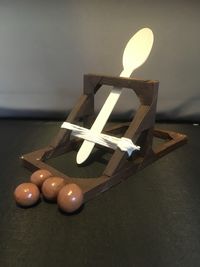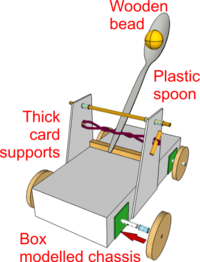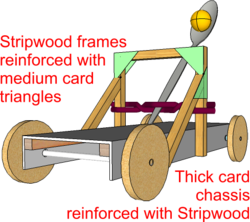Mangonel: Difference between revisions
From DT Online
mNo edit summary |
No edit summary |
||
| (5 intermediate revisions by the same user not shown) | |||
| Line 1: | Line 1: | ||
[[File:Ballist, fig 1, Nordisk familjebok.png| | [[File:Ballist, fig 1, Nordisk familjebok.png|450px|right|Mangonel]] | ||
__TOC__ | |||
[[File:MangonelC.jpg|200px|right|Mangonel]] | |||
=====Introduction===== | |||
The term [https://en.wikipedia.org/wiki/Mangonel '''Mangonel'''] is derived from a word the Greeks used for any engine-type military weapon. It means ‘engine of war’. '''[[Onager]]''' and [https://en.wikipedia.org/wiki/Mangonel '''Mangonel'''] can be regarded as essentially the same machines. Indeed there seems to be some interchangeability between the names of [https://en.wikipedia.org/wiki/Torsion_siege_engine#Terminology '''Siege Engines'''] generally. | The term [https://en.wikipedia.org/wiki/Mangonel '''Mangonel'''] is derived from a word the Greeks used for any engine-type military weapon. It means ‘engine of war’. '''[[Onager]]''' and [https://en.wikipedia.org/wiki/Mangonel '''Mangonel'''] can be regarded as essentially the same machines. Indeed there seems to be some interchangeability between the names of [https://en.wikipedia.org/wiki/Torsion_siege_engine#Terminology '''Siege Engines'''] generally. | ||
It is possible that the [https://en.wikipedia.org/wiki/Mangonel '''Mangonel'''] referred to in the '''[[:Category:Middle Ages|Middle Ages]]''' differed from the Roman '''[[Onager]]''' and was more like a small '''[[Trebuchet]]''' with a fixed counter-weight which was pulled down by several men. This way, with trained workers, the leader of the | It is possible that the [https://en.wikipedia.org/wiki/Mangonel '''Mangonel'''] referred to in the '''[[:Category:Middle Ages|Middle Ages]]''' differed from the Roman '''[[Onager]]''' and was more like a small '''[[Trebuchet]]''' with a fixed counter-weight which was pulled down by several men. This way, with trained workers, the leader of the team could adjust the strength applied to the [https://en.wikipedia.org/wiki/Mangonel '''Mangonel''']. | ||
An alternative suggestion is that a [https://en.wikipedia.org/wiki/Mangonel '''Mangonel'''], instead of a short [https://en.wikipedia.org/wiki/Sling_(weapon) '''Sling'''], had a fixed bowl at the end of arm which could be loaded with stones, fire pots or rotting corpses etc. | |||
=====Stripwood Model Mangonel===== | |||
[[File:MangonelBoxBaseLabelled.png|200px|right|Mangonel Box Model]] | |||
A reasonably quick and easy way to make a model '''Mangonel''' is based on a '''[[Rolling Chassis]]''' made by '''[[Box Modelling]]'''. | |||
* Choose a suitable size box as a starting point ''<span style="color: green">('''Note:''' for best results, turn the box inside out and re-assemble to reveal a better surface for painting and gluing)''</span>. | |||
* Push axle holes into the card box with a pencil then glue over them a piece of card with a hole made by a '''[[:Category:Punches|Paper Punch]]'''. | |||
* Cut '''[[Paper and Card|Thick Card]]''' to the shape of the '''Mangonel''' centre frame sides and stiffen by adding '''[[:Category:Stripwood Technology|Stripwood]]''' where needed with '''[[Glues and Pastes|PVA Glue]]'''. | |||
* Insert a length of '''[[Dowel]]''' through holes punched near the top of the centre frame to create a stop bar - hold in place with short lengths of PVC tubing. | |||
* Push wide elastic bands through holes in the centre frame sides and secure in place with short lengths of Dowel. | |||
* Use the short lengths of '''[[Dowel]]''' to twist the elastic bands and insert a plastic spoon to create the throwing arm. | |||
---- | |||
<span style="color: red">'''Safety Point!''' | |||
Use a '''[[Cutting Mat]]''' and a metal '''[[Safety Ruler]]''' when using a '''[[Craft Knife|knife]]''' to cut card | |||
</span> | |||
---- | |||
[[File:MangonelCardBaseLabelled.png |250px|right|Model Mangonel]] | |||
An alternative construction is to start with a rectangle of [[Paper and Card|thick card]] reinforced with lengths of '''[[:Category:Stripwood Technology|Stripwood]]'''. | |||
* Cut a rectangle of '''[[Paper and Card|Thick Card]]''' ''(210mm x 100mm)'' and cut narrow strips ''(210mm x 25mm)'' to form [https://en.wikipedia.org/wiki/Chassis '''Chassis'''] and sides as shown | |||
* Hold strips of timber in a small '''[[Stripwood_Technology_Tools#Holding_and_Clamping|Clamp-on Vice]]''' and cut to length using a '''[[Stripwood_Technology_Tools#Sawing_and_Cutting|Junior Hacksaw]]'''. | |||
* Glue the lengths of '''[[:Category:Stripwood Technology|Stripwood]]''' along the long sides of the rectangle and use these to glue the sides on. | |||
* Similarly, cut lengths of '''[[:Category:Stripwood Technology|Stripwood]]''' to make the central vertical frame approximately 100mm high above the chassis and glue to the [https://en.wikipedia.org/wiki/Chassis '''Chassis'''] sides together with angled '''[[:Category:Stripwood Technology|Stripwood]]''' bracing pieces. | |||
* Glue 30mm x 30mm triangles of [[Paper and Card|medium thickness card]] over each join as shown. | |||
* Wrap elastic around the lower half of the vertical centre frame to make the '''[[Torsion]]''' spring, then insert a plastics spoon to make the throwing arm | |||
* When released, the throwing arm will quickly swing upwards, powered by the '''[[Torsion]]''' spring, until it hits against the stop bar and releases the ammunition. | |||
---- | ---- | ||
<span style="color: | <span style="color: red">'''Safety Point!''' | ||
Use table tennis balls, squash balls or wooden beads as ammunition for example - NEVER use anything sharp or heavy | |||
</span> | </span> | ||
---- | ---- | ||
{{SiegeWeapons}} | |||
{{Box Modelling Buyers Guide}} | {{Box Modelling Buyers Guide}} | ||
| Line 18: | Line 54: | ||
[[Category:The Romans]] | [[Category:The Romans]] | ||
[[Category:Middle Ages]] | [[Category:Middle Ages]] | ||
[[Category:Norman Conquest]] | |||
[[Category:Primary Technology]] | |||
Latest revision as of 12:53, 7 May 2021
Introduction
The term Mangonel is derived from a word the Greeks used for any engine-type military weapon. It means ‘engine of war’. Onager and Mangonel can be regarded as essentially the same machines. Indeed there seems to be some interchangeability between the names of Siege Engines generally.
It is possible that the Mangonel referred to in the Middle Ages differed from the Roman Onager and was more like a small Trebuchet with a fixed counter-weight which was pulled down by several men. This way, with trained workers, the leader of the team could adjust the strength applied to the Mangonel.
An alternative suggestion is that a Mangonel, instead of a short Sling, had a fixed bowl at the end of arm which could be loaded with stones, fire pots or rotting corpses etc.
Stripwood Model Mangonel
A reasonably quick and easy way to make a model Mangonel is based on a Rolling Chassis made by Box Modelling.
- Choose a suitable size box as a starting point (Note: for best results, turn the box inside out and re-assemble to reveal a better surface for painting and gluing).
- Push axle holes into the card box with a pencil then glue over them a piece of card with a hole made by a Paper Punch.
- Cut Thick Card to the shape of the Mangonel centre frame sides and stiffen by adding Stripwood where needed with PVA Glue.
- Insert a length of Dowel through holes punched near the top of the centre frame to create a stop bar - hold in place with short lengths of PVC tubing.
- Push wide elastic bands through holes in the centre frame sides and secure in place with short lengths of Dowel.
- Use the short lengths of Dowel to twist the elastic bands and insert a plastic spoon to create the throwing arm.
Safety Point! Use a Cutting Mat and a metal Safety Ruler when using a knife to cut card
An alternative construction is to start with a rectangle of thick card reinforced with lengths of Stripwood.
- Cut a rectangle of Thick Card (210mm x 100mm) and cut narrow strips (210mm x 25mm) to form Chassis and sides as shown
- Hold strips of timber in a small Clamp-on Vice and cut to length using a Junior Hacksaw.
- Glue the lengths of Stripwood along the long sides of the rectangle and use these to glue the sides on.
- Similarly, cut lengths of Stripwood to make the central vertical frame approximately 100mm high above the chassis and glue to the Chassis sides together with angled Stripwood bracing pieces.
- Glue 30mm x 30mm triangles of medium thickness card over each join as shown.
- Wrap elastic around the lower half of the vertical centre frame to make the Torsion spring, then insert a plastics spoon to make the throwing arm
- When released, the throwing arm will quickly swing upwards, powered by the Torsion spring, until it hits against the stop bar and releases the ammunition.
Safety Point! Use table tennis balls, squash balls or wooden beads as ammunition for example - NEVER use anything sharp or heavy
Activity: Find out about Roman Siege Equipment (e.g. Vinea, Pluteus, Mantelet, Testudo, Musculus, Helepolis, Turris, Corvus, Ballista, Onager, Mangonel, Trebuchet, Aries (Battering Ram) and construct a working model or models using Stripwood Technology.
Safety Point! Take great care with hot glue guns and all hot-melt glues. The melted glue can stick to the skin and cause severe burns.














